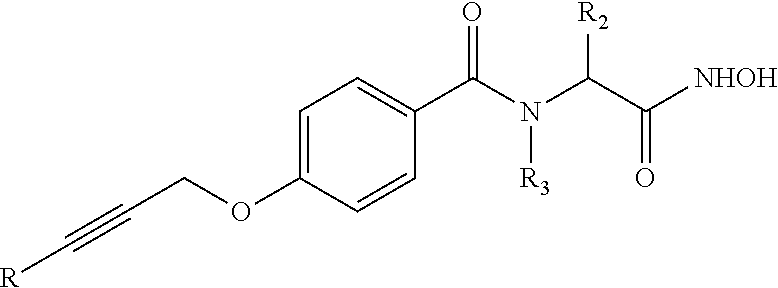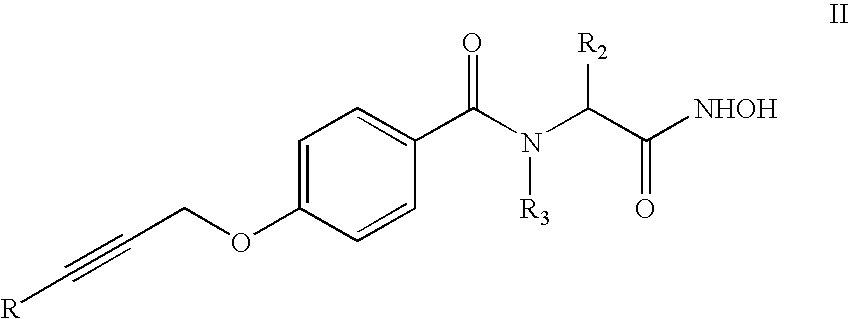Organic compounds and their uses
a technology of organic compounds and compounds, applied in the field of treating bacterial infections, can solve the problems of increasing the prevalence of resistance among nosocomial pathogens, increasing morbidity, mortality, and costs associated with nosocomial infections, and high resistance ra
- Summary
- Abstract
- Description
- Claims
- Application Information
AI Technical Summary
Benefits of technology
Problems solved by technology
Method used
Image
Examples
example 1
N-(1-(1-aminocyclopropyl)-2-(hydroxyamino)-2-oxoethyl)-4-(but-2-ynyloxy)benzamide (Compound 1)
[0330]
Step 1-A:
[0331]
[0332]A mineral oil dispersion of sodium hydride (60% by weight, 0.17 g, 7.23 mmol) is added to a solution of methyl-4-hydroxy benzoate (1.0 g, 6.57 mmol) in dimethyl formamide (20 mL) at 0° C. The mixture is stirred for 1 hour after which 1-bromo-2-butyne (0.96 g, 7.23 mmol) is added. The reaction mixture is gradually warmed to room temperature and stirred for overnight. The reaction is quenched with a saturated solution of ammonium chloride and extracted with ethyl acetate. The combined organic layers are washed with brine. The organic layer is dried over MgSO4, filtered and concentrated in vacuo. The residue is chromatographed on silica gel (gradient: EtOAc / hexane; 0:1 to 1:1) to afford 1a (0.79 g). Found m / z ES+=205.
Step 1-B:
[0333]
[0334]A solution of potassium hydroxide in aqueous 70% methanol (1N, 19 mL) is added to a solution of 1a (0.79g, 3.87 mmol) in THF (20 mL...
example 2
N-(3-amino-1-(hydroxyamino)-3-methyl-1-oxobutan-2-yl)-4-(but-2-ynyloxy)benzamide (Compound 2)
[0347]
Step 2-A:
[0348]
[0349]Compound 2a is synthesized according to the procedure described in J. Chem. Soc. Perkin. Trans. 1, 1999, 2659-2660.
Step 2-B:
[0350]
[0351]Thionyl chloride (11.0 g, 92.4 mmol) is slowly added to a mixture of 2a (3.00 g, 18.5 mmol) in MeOH (50 mL), and the solution is stirred for 8 days at 70° C. to 75° C. Additional MeOH (5 mL) and SOCl2 (1.0 g) is added to the reaction mixture daily. The volatiles are removed under reduced pressure to afford 3.90 g solid as product 2b.
Step 2-C:
[0352]
[0353]A mixture of 1b (400 mg, 2.11 mmol), 2b (692 mg, 3.26 mmol), HATU (1.20 g, 3.16 mmol) and DIPEA (876 mg, 6.77 mmol) is heated in dichloromethane (20 mL) at 60° C. for 1 day. Volatiles are removed and the residue purified using silica-gel chromatograpy to afford 560 mg product 2c. Found m / z ES+=349, ES−=347.
Step 2-D:
[0354]
[0355]Acetic acid (5.86 g, 9.77 mmol) is added to a mixture of...
example 3
N-(3-amino-1-(hydroxyamino)-3-methyl-1-oxobutan-2-yl)-4-(but-2-ynyloxy)benzamide (Compound 3)
[0361]
[0362]Compound 3, e.g., the other enantiomer of Compound 2, is prepared using the same procedure used to prepare compound 2 from enantiomerically pure starting material 2e.1 prepared in Step 2-E. LC-MS method 1, Rt=0.59 min.; Found m / z ES+=320 and ES−=318. 1H NMR (400 MHz, DMSO-d6, HCl salt) δ=11.2 (s, 1H), 9.20 (bs, 1H), 8.39 (bs, 1H), 8.11 (bs, 3H), 7.96 (d, 2H), 7.05 (d, 2H), 4.83 (q, 2H), 4.68 (d, 1H), 1.83 (t, 3H), 1.34 (s, 3H), 1.30 (s, 3H).
PUM
| Property | Measurement | Unit |
|---|---|---|
| enantiomeric excess | aaaaa | aaaaa |
| enantiomeric excess | aaaaa | aaaaa |
| enantiomeric excess | aaaaa | aaaaa |
Abstract
Description
Claims
Application Information
 Login to View More
Login to View More - R&D
- Intellectual Property
- Life Sciences
- Materials
- Tech Scout
- Unparalleled Data Quality
- Higher Quality Content
- 60% Fewer Hallucinations
Browse by: Latest US Patents, China's latest patents, Technical Efficacy Thesaurus, Application Domain, Technology Topic, Popular Technical Reports.
© 2025 PatSnap. All rights reserved.Legal|Privacy policy|Modern Slavery Act Transparency Statement|Sitemap|About US| Contact US: help@patsnap.com



